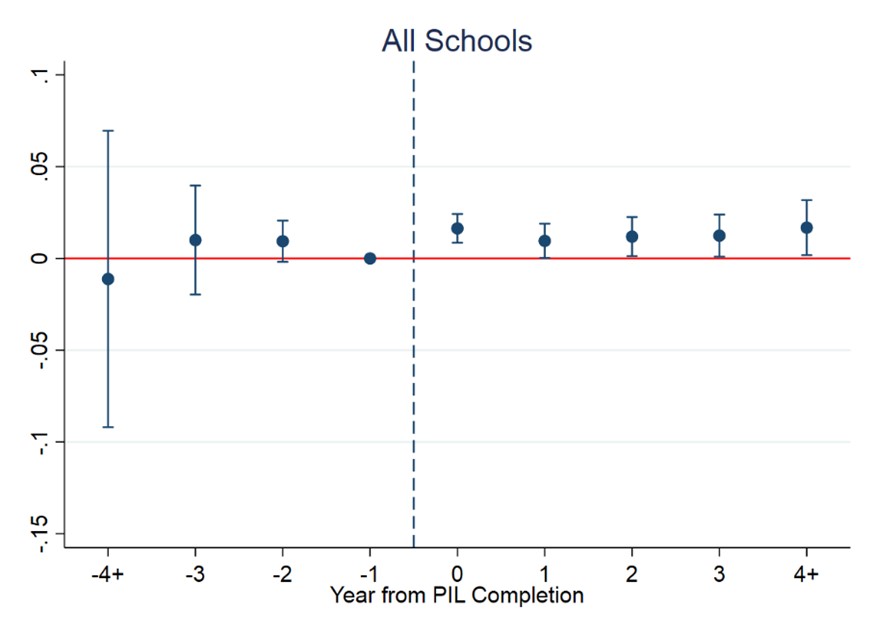Does Principal Professional Development Improve Schooling Outcomes? Evidence from Pennsylvania’s Inspired Leadership Induction Program
Matthew P. Steinberg and Haisheng Yang
Is principal induction effective at raising student achievement?
Yes, according to a study of Pennsylvania’s Inspired Leadership (PIL) induction program. In schools where principals completed the PIL induction program, teachers became more effective, resulting in modest improvements in student achievement of approximately 1-2 weeks of additional schooling. These benefits were concentrated in schools that served the most economically disadvantaged and minority students in urban districts.
Estimates of PIL Induction on Teacher Math Effectiveness

How to read this chart: This chart shows that PIL induction improved teacher math effectiveness, which is measured in student-level standard deviation units, in the years following the completion of principal induction. On average, PIL induction improved teachers’ value-added contribution to student math achievement by 0.01 to 0.03 student-level standard deviations, corresponding to approximately 1-2 weeks of additional schooling.
What is Pennsylvania’s Inspired Leadership (PIL) induction?
The Pennsylvania Inspired Leadership (PIL) induction program was introduced through Pennsylvania’s Act 45 of 2007, which formalized principal professional development for early career principals. Beginning in January 2008, newly hired principals in Pennsylvania were required to complete formal coursework via the National Institute for School Leadership (NISL) within the first five years of employment. PIL induction consisted of two required courses: World-Class Schooling, which provided principals with strategic planning skills to implement a vision of high-quality teaching and student achievement; and Driving for Results, which trained principals to examine student achievement and many other types of data to identify school, teacher and individual student needs.
How did we do this study?
These findings are from a quasi-experimental study, which falls under Tier II of the ESSA standards. We define the program at the school-year level and include principals who did not complete PIL induction in the control group to estimate the effect of PIL induction. We employ a difference-in-differences strategy which compares changes in outcomes before and after the completion of PIL induction to estimate whether PIL induction impacted teacher- and student-level outcomes, including teacher effectiveness, teacher mobility and student academic achievement. We rely on two comparison groups in our study; first, we include all school-year observations from the 2008-09 through 2015-16 academic years; and second, we restrict our comparisons to a sample that included only novice and early career principals to address the potential that including more experienced principals in the comparison group may understate PIL induction effects.
Full Article Citation: Steinberg, M., & Yang, H. (2022). Does principal professional development improve schooling outcomes? Evidence from Pennsylvania’s Inspired Leadership induction program. Journal of Research on Educational Effectiveness. DOI: https://doi.org/10.1080/19345747.2022.2052386.
